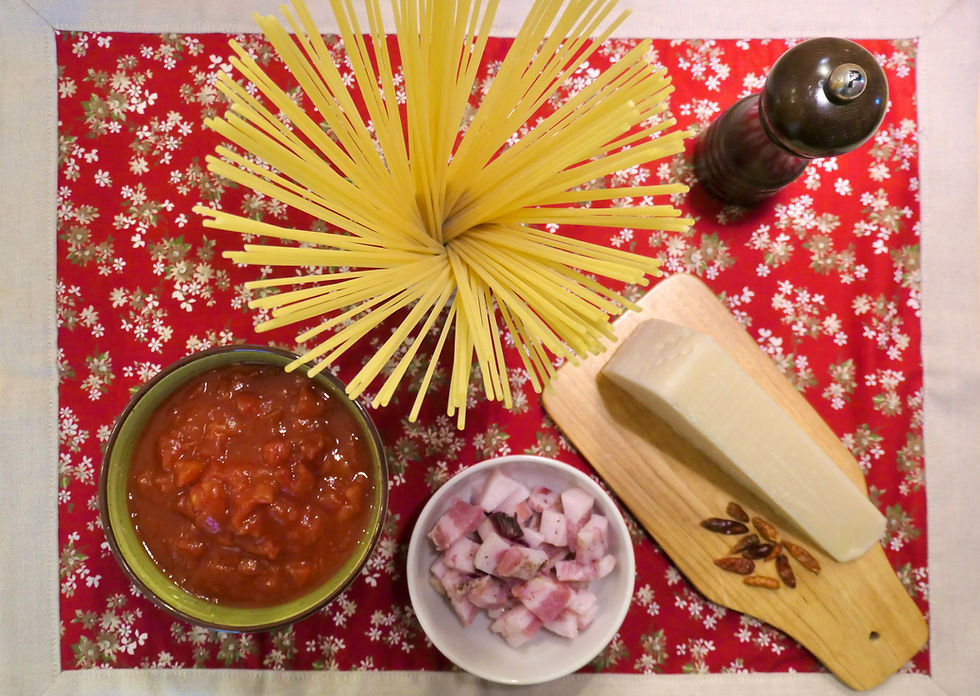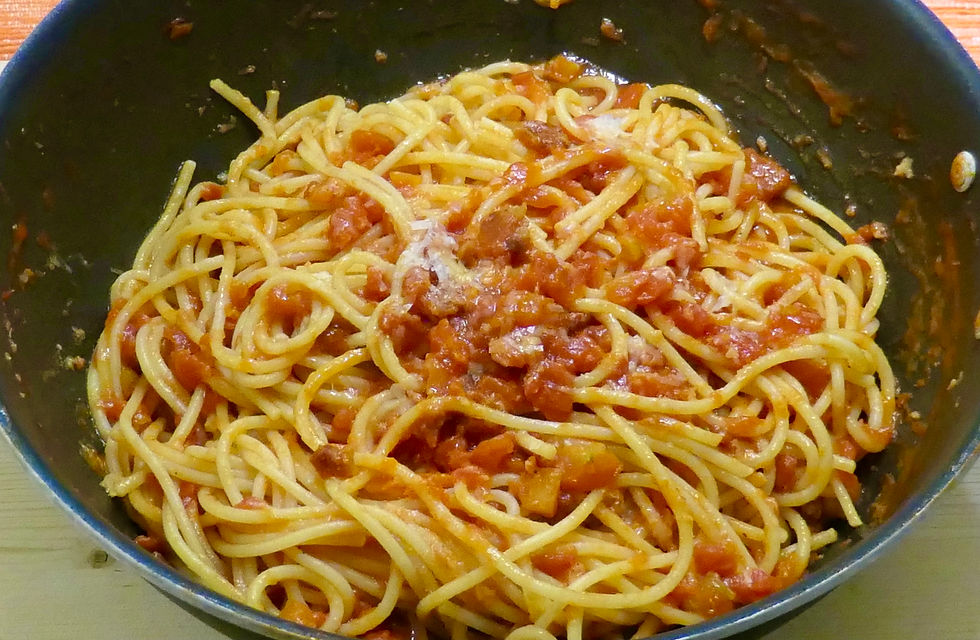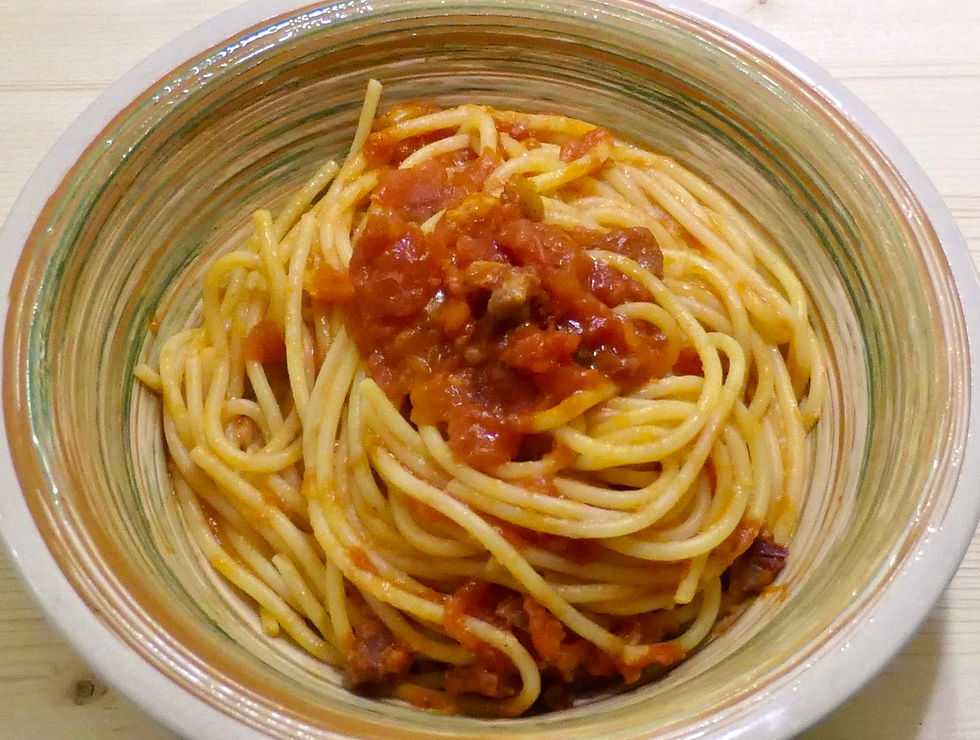Spaghetti all'Amatriciana
- May 16, 2021
- 4 min read
Updated: Nov 29, 2024
Another classic Lazio dish with very few ingredients. Another traditional recipe that almost every English language website seems to disdain as being so simple that they shamelessly mangle it through ignorance or laziness. And just like Cacio e Pepe, they mess up the process (no you don't add the raw canned tomatoes to the cooked guanciale!) or the ingredients, starting with the tomato (no it's not passata it's pomodori pelati!) and then the cheese (no it's not parmigiano it's pecorino romano or at the very least pecorino stagionato!).


Who exactly are all these confused and misguided food bloggers? Do they really think that mountainous Amatrice is surrounded by grazing cows and not sheep? Pecora is the Italian word for a sheep so what part of pecorino don't they understand, and don't they realize that Parmigiano Reggiano is made from cow's milk and is from Emilia Romagna?
It's just not possible to have a centuries old regional Italian recipe that depends on an ingredient imported from hundreds of miles away across mountains. How many ways can people screw up a recipe with only 4 ingredients? And no, you really shouldn't add onions and definitely not garlic. And if you must add the wrong cheese and all these other ingredients then at least give your dish a different name.
Much like Cacio e Pepe, the original 'white' Pasta all'amatriciana (ie without the tomatoes), known to Italians as Gricia, was a simple dish that the shepherds would make during the transumanza. The transumanza was the name for the annual migration of shepherds with their flocks of sheep from the coastal plains near Rome to the high summer pastures of the Monti della Laga, where Amatrice is located. With the addition of tomatoes, Gricia became all'amatriciana.
Elena and I have been to Amatrice from where this dish gets its name. It's in the mountains closer to the Adriatic than Rome and though it's in Lazio it's very close to the western borders of both le Marche and Abruzzo. In fact until Mussolini changed the border in 1927, Amatrice was an Abruzzese village in the province of l'Aquila. It's also in the middle of the worst earthquake zone in Italy and unfortunately suffered terribly from one five years ago.

Elena's mother Lisa frequently made this dish in Rome when she lived there in the 1950s, but rather than just taking our word for the proper way of making it, we've also attached a 17 minute video of our favorite Roman chef, Max Mariola, who does it the right way and he has conveniently attached a few English sub-titles on this video.
Note that we deliberately did not call this dish Bucatini all'amatriciana as Max does because although this is the pasta that Romans use, in Amatrice itself they mostly use spaghetti and call the dish Spaghetti all'amatriciana. It can also be served with a short pasta, typically rigatoni. We suggest you follow how Max does it in his video because this is the best example we could find of the proper process. You can then enjoy this dish as if you were in Amatrice. First, however, you'll have to find some guanciale or at least some thickly cut pancetta, but nothing smoked.
Ingredients for 2 people:
280 grams (10 oz) spaghetti
60 grams (2 oz) finely grated pecorino romano DOP
80 grams (3 oz) guanciale, thickly cut into ½ inch by ½ inch pieces (or thickly cut pancetta to substitute)
450 grams (16 oz) peeled San Marzano plum tomatoes
half glass of dry white wine
1 or 2 small chili peppers left whole or cut in half, but not diced (optional)
sea salt and freshly ground black pepper
Directions:
1. Sauté the guanciale on a low medium heat for 7 to 10 minutes, preferably without adding any olive oil. Move the pieces around constantly with a wooden spoon towards the finish so they become a little croccante (crisp) but don't let them burn. Stirring them is important so the fat renders more completely.
2. Remove the guanciale with a slotted spoon and set aside. Pour off the transparent rendered fat carefully to re-use but discard the remaining dark fat (see video below at exactly 8 minutes elapsed).
3. Wipe the pan clean, add the transparent fat back and when hot again add a generous half glass of white wine and let the alcohol burn off for about a minute.
4. Add the tomatoes to the sauce pan, squeezing the peeled tomatoes by hand a little as you add them. Cook the crushed tomatoes on a medium heat for about 20 minutes stirring them into the guanciale fat so the sauce thickens a little with evaporation. Season with salt and pepper. The consistency of the finished sauce should be such that when you drag the spoon through it you will see the bottom of the pan briefly before the sauce covers the gap again, so not too runny and not too thick.

5. Add the pasta to the boiling water when the tomato sauce has been cooking for about 10 minutes and there is another 10 minutes remaining.
6. When still a little al dente add the pasta to the sauce and finish cooking for a minute then turn the heat off, allow to rest for a minute and stir in the pecorino and the reserved pieces of guanciale. Finish with a slug of good quality Italian olive oil if you like.
Wine Match:
A case could be made here for either a red wine or a white wine. Given that Amatrice was historically part of Abruzzo the famous red wine of that region, Montepulciano d'Abruzzo would be the natural choice. Alternatively a Lazio white wine like the little known Illirio from the excellent co-operative Cincinnato would also work. See Wine Tasting section.